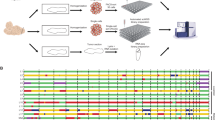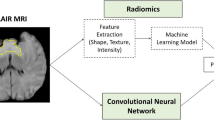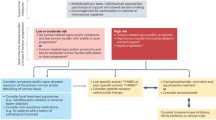Abstract
Paragangliomas of the head and neck region, also known as glomus tumours, are mostly benign tumours of neuro-ectodermal origin. We mapped the familial form by linkage analysis in 6 families to chromosome region 1 1q22–q23, between the markers STMY and CD3D which currently span a 16-cM interval. Here, we performed detailed haplotype analysis of this region in a single Dutch multibranch 7-generation family. A region of 2 cM between the markers D11S938/D11S4122 and D11S1885 was shared between all patients of whom disease haplotypes could be reconstructed. In support of this localization, a recombination observed in a small French family with 2 affected nieces places the PGL gene proximal to marker D11S908, genetically coincident with D11S1885.
Similar content being viewed by others
Log in or create a free account to read this content
Gain free access to this article, as well as selected content from this journal and more on nature.com
or
References
Zak FG, Lawson W: The Paragangliomic Chemoreceptor System: Physiology, Pathology and Clinical Medicine. New York, Springer, 1982, p 583.
Van der Mey AGL, Maaswinkel-Mooy PD, Cornelisse CJ, Schmidt PH, van de Kamp JJP: Genomic imprinting in hereditary glomus tumors: Evidence for new genetic theory. Lancet 1989;ii:1291–1294.
Barlow DP: Imprinting: A gamete’s point of view. Trends Genet 1994;10:194–199.
Heutink P, van der Mey AGL, Sandkuyl LA, van Gils APG, Breedveld G, Bardoel A, van Vliet M, Cornelisse CJ, Oostra B, Devilee P: A gene subject to genomic imprinting and associated with hereditary paragangliomas maps to chromosome 11q23-qter. Hum Mol Genet 1992;1:7–10.
Heutink P, van Schothorst EM, van der Mey AGL, Bardoel AFJ, Breedveld G, Pertijs J, Sandkuijl LA, van Ommen GJB, Cornelisse CJ, Oostra BA, Devilee P: Further localisation of the gene for hereditary paragangliomas (PGL), and evidence for linkage in unrelated families. Eur J Hum Genet 1994;2:148–158.
Dib C, Fauré S, Fizames C, Samson D, Drouot N, Vignal A, Millasseau P, Marc S, Hazan J, Seboun E, Lathrop M, Gyapay G, Morissette J, Weissenbach J: A comprehensive genetic map of the human genome based on 5,264 microsatellites. Nature 1996;380:152–154.
Mariman ECM, van Beersum SEC, Cremers CWRJ, van Baars FM, Ropers HH: Analysis of a second family with hereditary non-chromaffin paragangliomas locates the underlying gene at the proximal region of chromosome 11q. Hum Genet 1993;91:357–361.
Mariman ECM, van Beersum SEC, Cremers CWRJ, Struycken PM, Ropers HH: Fine mapping of a putatively imprinted gene for familial non-chromaffin paragangliomas to chromosome 11q13.1: Evidence for genetic heterogeneity. Hum Genet 1995;95:56–62.
Oosterwijk JC, Jansen JC, van Schothorst EM, Oosterhof AW, Devilee P, Bakker E, Zoeteweij MW, van der Mey AGL: First experiences with genetic counselling based on predictive DNA diagnosis in hereditary glomus tumors (paragangliomas). J Med Genet 1996;33:379–383.
Van Gils APG, Falke THM, van Erkel AR, Arndt J-W, Sandler MP, van der Mey AGL, Hoogma RPLM: MR imaging and MIBG scintigraphy of pheochromocytomas and extraadrenal functioning paragangliomas. Radiographics 1991;11:37–57.
Miller SA, Dykes DD, Polesky HF: A simple salting out procedure for extracting DNA from human nucleated cells. Nucleic Acids Res 1988;16:1214–1215.
Weber JL, May PE: Abundant class of human DNA polymorphisms which can be typed using the polymerase chain reaction. Am J Hum Genet 1989;44:388–396.
Lathrop GM, Lalouel JM: Easy calculations of lod scores and genetic risks on a small computer. Am J Hum Genet 1994;36:460–465.
Gruis NA, Sandkuijl LA, van der Velden PA, Bergman W, Frants RR: CDKN2 explains part of the clinical phenotype in Dutch familial atypical multiple mole-melanoma (FAMMM) syndrome families. Melanoma Res 1995;5: 169–177.
NIH-CEPH Collaborative Mapping Group: A comprehensive genetic linkage map of the human genome. Science 1992;258:67–102.
Litt M, Kramer P, Kort E, Fain P, Cox S, Root D, White R, Weissenbach J, Donis-Keller H, Gatti R, Weber J, Nakamura Y, Julier C, Hayashi K, Spurr N, Dean M, Mandel J, Kidd K, Kruse T, Retief A, Bale A, Meo T, Vergnaud G, Warren S, Willard HF: The CEPH Consortium linkage map of human chromosome 11. Genomics 1995;27:101–112.
Gyapay G, Morisette J, Vignal A, Dib C, Fizames C, Millasseau P, Marc S, Bernardi G, Lathrop M, Weissenbach J: The 1993–94 Généthon human genetic linkage map. Nat Genet 1994;7:246–339.
James MJ, Ricard CW III, Schott J-J, Yousry C, Clark K, Bell J, Terwilliger JD, Hazan J, Dubay C, Vignal A, Agrapart M, Imai T, Nakamura Y, Polymeropoulos M, Weissenbach J, Cox DR, Lathrop GM: A radiation hybrid map of 506 STS markers spanning human chromosome 11. Nat Genet 1994;8:70–76.
McCaffrey TV, Meyer FB, Michels VV, Piepgras DG, Marion MS: Familial paragangliomas of the head and the neck. Arch Otolaryngol Head Neck Surg 1994;120:1211–1216.
Weber JL, Wong C: Mutation of human short tandem repeats. Hum Mol Genet 1993;2:1123–1128.
Hästbacka J, De la Chapelle A, Mahtani MM, Clines G, Reeve-Daly MP, Daly M, Hamilton BA, Kusumi K, Trivedi B, Weaver A, Coloma A, Lovett M, Buckler A, Kaitila I, Lander ES: The diastrophic dysplasia gene encodes a novel sulfate transporter: Positional cloning by fine-structure linkage disequilibrium mapping. Cell 1994;78:1073–1087.
Ramsay M, Williamson R, Estivill X, Wainwright BJ, Ho M-F, Halford S, Kere J, Savilahti E, De la Chapelle A, Schwartz M, Schwartz M, Super M, Farndon P, Harding C, Meredith L, Al-Jader L, Ferec C, Claustres M, Casals T, Nunes V, Gasparini P, Savoia A, Pignatti PF, Novelli G, Bennarelli M, Dallapiccola B, Kalaydjieva L, Scambler PJ: Haplotype analysis to determine the position of a mutation among closely linked DNA markers. Hum Mol Genet 1993;2:1007–1014.
Devilee P, van Schothorst EM, Bardoel AFJ, Bonsing B, Kuipers-Dijkshoorn N, James MJ, Fleuren G, van der Mey AGL, Cornelisse CJ: Allelotype of head and neck paragangliomas: Allelic imbalance is confined to the long arm of chromosome 11, the site of the predisposing locus PGL. Genes Chrom Cancer 1994;11:71–78.
Nyström-Lahti M, Sistonen P, Mecklin J-P, Pylkkänen L, Aaltonen LA, Järvinen H, Weissenbach J, De la Chapelle A, Peltomäki P: Close linkage to chromosome 3p and conservation of ancestral founding haplotype in hereditary nonpolyposis colorectal cancer families. Proc Natl Acad Sci USA 1994;91:6054–6058.
Houwen RHJ, Baharloo S, Blankenship K, Raeymaekers P, Juyn J, Sandkuijl LA, Freimer NB: Genome screening by searching for shared segments: Mapping a gene for benign recurrent intrahepatic cholestasis. Nat Genet 1994;8: 380–386.
Pàldi A, Gyapay G, Jami J: Imprinted chromosomal regions of the human genome display sex-specific meiotic recombination frequencies. Curr Biol 1995;5:1030–1035.
Reik W, Brown KW, Schneid H, Le Bouc Y, Bickmore W, Maher ER: Imprinting mutations in the Beckwith-Wiedemann syndrome suggested by an altered imprinting pattern in the IGF2-H19 domain. Hum Mol Genet 1995;4: 2379–2385.
Buiting K, Saitoh S, Gross S, Dittrich B, Schwartz S, Nicholls RD, Horsthemke B: Inherited microdeletions in the Angelman and Prader-Willi syndromes define an imprinting centre on human chromosome 15. Nat Genet 1995;9:395–400.
Acknowledgements
We thank all family members for their cooperation. We thank Dr. M. Schlumberger (Institut Gustave-Roussy, Villejuif, France) for referring family FGT21 and Dr. L. Sandkuijl for his statistical advice. This work was supported by the Dutch Organisation for Scientific Research (NWO 900-715-816) and the Dutch Cancer Society (KWF 93-537).
Author information
Authors and Affiliations
Rights and permissions
About this article
Cite this article
van Schothorst, E.M., Jansen, J.C., Bardoel, A.F.J. et al. Confinement of PGL, an Imprinted Gene Causing Hereditary Paragangliomas, to a 2-cM Interval on 11q22–q23 and Exclusion of DRD2 and NCAM as Candidate Genes. Eur J Hum Genet 4, 267–273 (1996). https://doi.org/10.1159/000472213
Received:
Accepted:
Issue date:
DOI: https://doi.org/10.1159/000472213
Key Words
This article is cited by
-
A powerful parent-of-origin effects test for qualitative traits incorporating control children in nuclear families
Journal of Human Genetics (2012)
-
The Dutch founder mutation SDHD.D92Y shows a reduced penetrance for the development of paragangliomas in a large multigenerational family
European Journal of Human Genetics (2010)



